Engineering David Bowie’s “The Next Day” — Inside the Magic Shop Sessions with Mario J. McNulty
Instant classics are hard to come by. That’s what explains all the excitement around David Bowie’s new album, The Next Day.
When was the last time in music history that a record has earned so much global adulation – before it’s even been released? But the record is a thrilling listen for rock listeners the world over, because one of the craft’s most experienced practitioners has pioneered even further.
A big part of Bowie’s accomplishment was enabled by his devoted band and production/engineering team, all of whom sacredly respected a vow of secrecy about the album’s creation. Amazingly, word never leaked about its recording – a process that unfolded over two years, with three different in-studio bands.
SoHo’s Magic Shop was the proud audio HQ for The Next Day, an artful and driving record that provides the unique feeling that David Bowie alone can deliver. As Bowie’s first studio record since 2003’s Reality – and the 30th of his career – this album was going to have to be special.
No surprise then, that Magic Shop was host not just to Bowie and his world-class bands of musicians, but to the famed Tony Visconti, who’s been the producer on many of Bowie’s landmark works. The pair’s collaboration starts with 1969’s Space Oddity, and goes on to include The Man Who Sold the World (1970), David Live (1974), Diamond Dogs (1974), Young Americans (1975), Low (1977), Heroes (1977), Lodger (1979), Scary Monsters (1980), Heathen (2002), and Reality (2003), among them.
But of course, David Bowie’s right-hand man needs a right-hand man himself, and that distinction goes to the NYC-based engineer Mario J. McNulty. In addition to engineering for Visconti for the past 11 years, McNulty has built up a GRAMMY-winning career nailing down sounds for artists including Prince, Laurie Anderson, Angelique Kidjo, Lou Reed, Nine Inch Nails, Imelda May, Manic Street Preachers, Kashmir, Anti-Flag, Alejandro Escovedo, and Lucy Woodward.
McNulty earned the extreme privilege of being onsite for the recording of The Next Day at the Magic Shop. But more than just bearing witness, McNulty – along with Magic Shop engineer Brian Thorn and project manager Kabir Hermon — was a critical vessel for Bowie and Visconti’s audio vision, swiftly putting their plans into action so the masters could make music.
“It’s been a dream come true to work with David in my career,” says McNulty. “He’s my biggest influence, so being in the studio with him and Tony is fantastic every time. David is so charismatic, and also so extremely smart, that working with him is always a fulfilling situation for me.
“There’s something exciting about David’s songwriting,” McNulty continues, “whether he’s playing riffs on a keyboard or a guitar, that’s unmistakably the sound of David. It’s a little abstract, but you know it when you hear it. Every day was fantastic, and it just doesn’t get better than that, working in a studio with an artist like him. That’s what we all want to do when we’re making records, is work with somebody of that caliber.
“When you’re working with a producer like Tony Visconti who’s obviously a veteran, an icon like David, and his band is a supergroup of some of the best players in the world, your job is not to just get the right sounds to tape, but make it seamless and easy. People have to come into the studio and not worry – instead get to their station, put the headphones on, and just create in a very comfortable fashion. You also have to know how to get sounds extremely fast. That’s probably the most important part of all in making a record like this.”
Between the ultra-secret nature of the Next Day sessions, and the fact that Tony Visconti generally prefers to keep his hard-earned engineering techniques to himself, the inside audio story of David Bowie’s latest album would seem pretty hard to come by. Fortunately, McNulty was willing to provide an engineer’s perspective on how the unmistakable sounds of Bowie’s latest/greatest came together.
Read on for our Q&A with McNulty, and discover some invaluable in-studio information that you’ll only find on SonicScoop:
How would you describe David and Tony’s working relationship – what makes them a high-functioning artist/producer team, in your opinion?
David and Tony have been working together for so long and know each other so well, that the work in the studio is very natural, never forced or tense. Tony is used to what David will expect in most situations, so I think that saves an immense amount of time.
Is there a way to characterize the sound that Tony Visconti wants to achieve when he’s recording David Bowie?
That’s a hard question to answer. Usually there’s a process in which I am recording in the way Tony is happy with and gives him enough options to work with, but also not going crazy so he doesn’t have to make too many decisions when it’s time to mix.
David and Tony both want the recording to sound like a record on playback, so dynamics go to tape all the time. There are times when a special sound is called for — if so then we will talk about it and change what might be my usual approach. Mostly though, it’s about not missing anything and getting all the performances to tape.
How would you describe the working relationship you have with Tony — how do you approach getting him the sounds that he wants in the studio?
I’ll always have a conversation with Tony about the sound of the record before we start, sometimes weeks or months before. Sometimes the artist or band might call for a traditional sound, but of course there are other times when a very specific technique is needed. I’ll have game plan in advance every time.
Be prepared! Next, tell us about the Magic Shop live room – what made this a good setting acoustically to capture Bowie and his bands?
The Magic Shop live room is what I would consider a medium-sized recording room. The room is treated so the reflections aren’t too crazy, plus the tall ceilings help. There were never any strange frequency pockets in the room that I had to worry about.
For many of the songs there were five people performing live in the room at once, that also changes the sound of the room a bit. I used Magic Shop’s two isolation cabinets for guitar amps and the bass cabinet, but even with those cabinets you have to deal with the small amount of bleed.
Because of this bleed and the fact that the performances were captured live, this might be a nightmare for many bands… but this band was incredible. When a group plays together that well you can record this way.
David finished lyrics after the basic tracking was done so there were no issues with keeping the scratch vocal. There were lots of overdubs of course, but all the live takes were kept and that’s what’s on the record.
You mentioned to me that David Bowie had a “recording station” – what was it equipped with, and how was it ergonomically laid out to allow him maximum creativity?
David’s station was laid out around the Baldwin piano. I made sure there was plenty of room for him to move about and also take notes if he needed to.
In addition David had his Trinity keyboard workstation, and acoustic 6-string and 12-string, a tambourine, and a digital mixer which he had some recordings on for reference. I had an SM7 for his live vocal takes going through the Neve, and hitting an LA-2A very softly.
The band was tracked through the fabulous Neve at Magic Shop, using EQ on each channel and additional compression for some microphones…A little compression for kicks, snares, bass guitar, and electric guitar.
There were three distinct groups in the studio with David Bowie, at different times. Band One was (guitars) Gerry Leonard and David Torn, (bass) Gail Ann Dorsey, (drums) Zack Alford; Band Two was (guitar) Gerry Leonard, (bass) Tony Levin, (drums) Zach Alford; Band Three was (guitar) Earl Slick, (bass) Tony Visconti, (drums) Sterling Campbell. Was there a difference in the overall recording approach to each of these different bands?
There was actually an effort to make a similar-sounding recording for each band, and that was one of Tony’s requests. I would have our assistant Brian Thorn recall everything for every song, and Brian did so in great detail. I could always reference an EQ setting from a previous month, for example.
Can you go into detail on some of the guitar recording signal paths/techniques?
The guitar setups were different for each player.
Gerry Leonard had two cabinet dual mono setup with his vast array of pedals. Gerry normally had a rhythm guitar to one cab, and FX to the other. I used an SM57 for the main cab and a Royer 122 on the FX cab, and using the Neve as front-end with each source discreetly hitting an LA-3A, which is my all time favorite electric guitar compressor.
Gerry also had this amazing white Synthi Hi Fli [synth/multi FX processor] which sounded insane in the best way.
For David Torn, his setup is quite complex, but all of his sounds end up going to three outputs/cabs. It’s an L-C-R rig: Dry guitar in the center, and ambience going to the left and right cabs. I had a SM57 for the center and AKG 414s for the left and right, with the Neve as the front end again with no compression to tape for Torn.
Slick’s setup was the rock and roll setup, it was a real no-brainer. Slick has this awesome-sounding Orange 2×12 with an AD30 head. It’s no nonsense: Slick plugs in, and it sounds HUGE. I used two mics both going to the Neve — an SM57 on one speaker, and a M160 ribbon on the other off-axis.
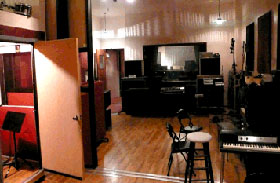
The Magic Shop’s Studio A live room is 1,000 sq. ft., with another 1,000 sq. ft. worth of iso booths to work with.
Tell us about recording the bass.
The bass rigs for Gail Ann Dorsey, Tony Levin, and Tony Visconti I kept the same, except for the gain stages. A great-sounding Music Valve tube DI, and an Ampeg B15 which sounded fantastic. I used a Neumann U67 for the cab, and both went to UREI 1176 compressors.
Now let’s give the drummer some…
Again with the drums, I tried to take a similar approach for both Sterling Campbell and Zach Alford.
All microphones going through the Neve, with a three-mic setup for kick drum which is pretty normal for me… D112, U47 — a couple feet back with a pop screen, and an NS-10 sub kick. I would normally use a FET47 for the kick, but used this U47 in this instance.
Three mics for the snare: SM57 top and bottom, plus an additional AKG 451, padded, on the top. The top two had some Distressors and dbx compression going on. For some songs Tony wanted to hear an old 441 on the snare, and that was what I used for some of the tracks Sterling played on.
Toms had both top and bottom mics as well, with Sennheiser 421’s on top for the classic rock sound, and my own Sennheiser e904 on the bottom. AKG 451’s again for rides and Hi Hats. KM84s for Zach’s overheads, and 414s for Sterling’s overheads. Room mics were 414’s hitting a Chandler EMI TG1 Limiter. I also used just s very slight amount of Neve 33609 compression on the overheads.
The drums themselves were an assortment… Zach playing mostly birch Yamaha drums and Sterling playing mostly maple GMS drums. We would swap out kick drums and snares for each song, so there was a variety to choose from there. Same situation with the cymbals, lots of choices from dark to bright, but only Zildjian cymbals were used. I also brought my own cymbals — I have a huge collection — and some snares to throw into the mix in case we needed any options for a particular song.
So backing off from the tech talk, what was a “Holy Sh*t!” point in the studio that you remember as an epic engineering moment?
I do remember a great moment — there are many with David — but there was one part he played on the bridge in, I believe, “Love Is Lost” that made me shiver.
The chord progression came out of nowhere when David put it down on the Trinity, it was pure magic. It wasn’t so much an engineering moment, but a musical one. I did say ‘Holy sh*t’ to myself!
Anything else you can tell us about this latest Bowie + Visconti experience?
I can only add that this record is one for the history books, I can’t ever see an artist like David with his status pulling off a secret album like this again. It’s an amazing record, and I am so lucky and honored have been involved.
— David Weiss
Please note: When you buy products through links on this page, we may earn an affiliate commission.







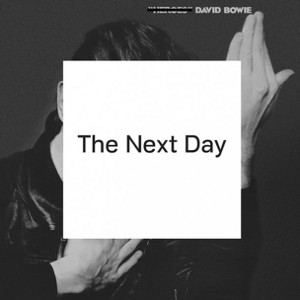

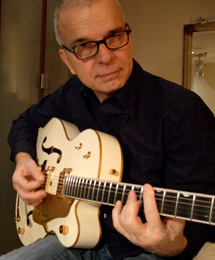
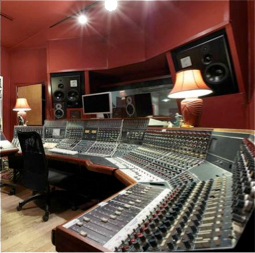
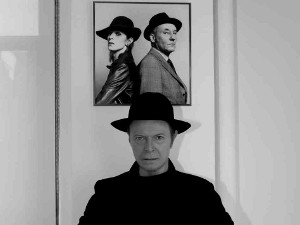
Christian Rosier
March 12, 2013 at 11:52 pm (12 years ago)Stream the whole album here on iTunes!
http://smarturl.it/DBowieAlbumStream
redsails1
March 14, 2013 at 3:45 am (12 years ago)Thankyou one and all for the detailed overview. It is great to hear how it all went down. Kudos to all involved… I wonder if Mario has received his signed CD yet?
Rob Allen
March 14, 2013 at 8:15 pm (12 years ago)I am waiting for the vinyl, just like the old days. I’ve already pre-ordered it!
Todd Simmons
March 30, 2013 at 3:55 pm (12 years ago)Thank you for this article. Great to get the studio/tech point of view on this recording. Outstanding album.
Marc Urselli
February 21, 2014 at 3:10 pm (11 years ago)Of course I would have loved to be there and experience this, but Mario is one of the very few New York engineer colleagues who truly deserved this and I am very happy for him and congratulate him on this great career achievement and musical experience!!!